Nursing Assignment: Comprehensive Assessment and OHS in Nursing
VerifiedAdded on 2023/06/10
|10
|2470
|330
Homework Assignment
AI Summary
This nursing assignment solution addresses a range of topics relevant to healthcare professionals, including assessment principles like justice, honesty, and various assessment methods (work-focused, criterion-referenced, standard-based, and evidence-based). It explores RPL and RCC, and details the components of a unit of competency. The document covers key aspects of workplace safety, including hazard identification, risk assessment, control measures, and reporting requirements. It also highlights the importance of PPE, employee consultation, and the role of safety officers. Furthermore, it defines competency-based and criterion-based assessments and discusses reasonable adjustments in VET. Additional topics include cultural considerations, legal aspects of copyright, security, and plagiarism. The assignment also touches on industry engagement, the assessor's duty of care, assessment results, and validation processes, along with the importance of workplace relations and legislative awards. Finally, it covers skills, knowledge, and attitudes needed in the workplace, as well as the storage of assessments, and the role of different skills in a job environment. The solution concludes with detailed information on assessment tools and validation methods, including the significance of regular validation for accuracy and integrity.
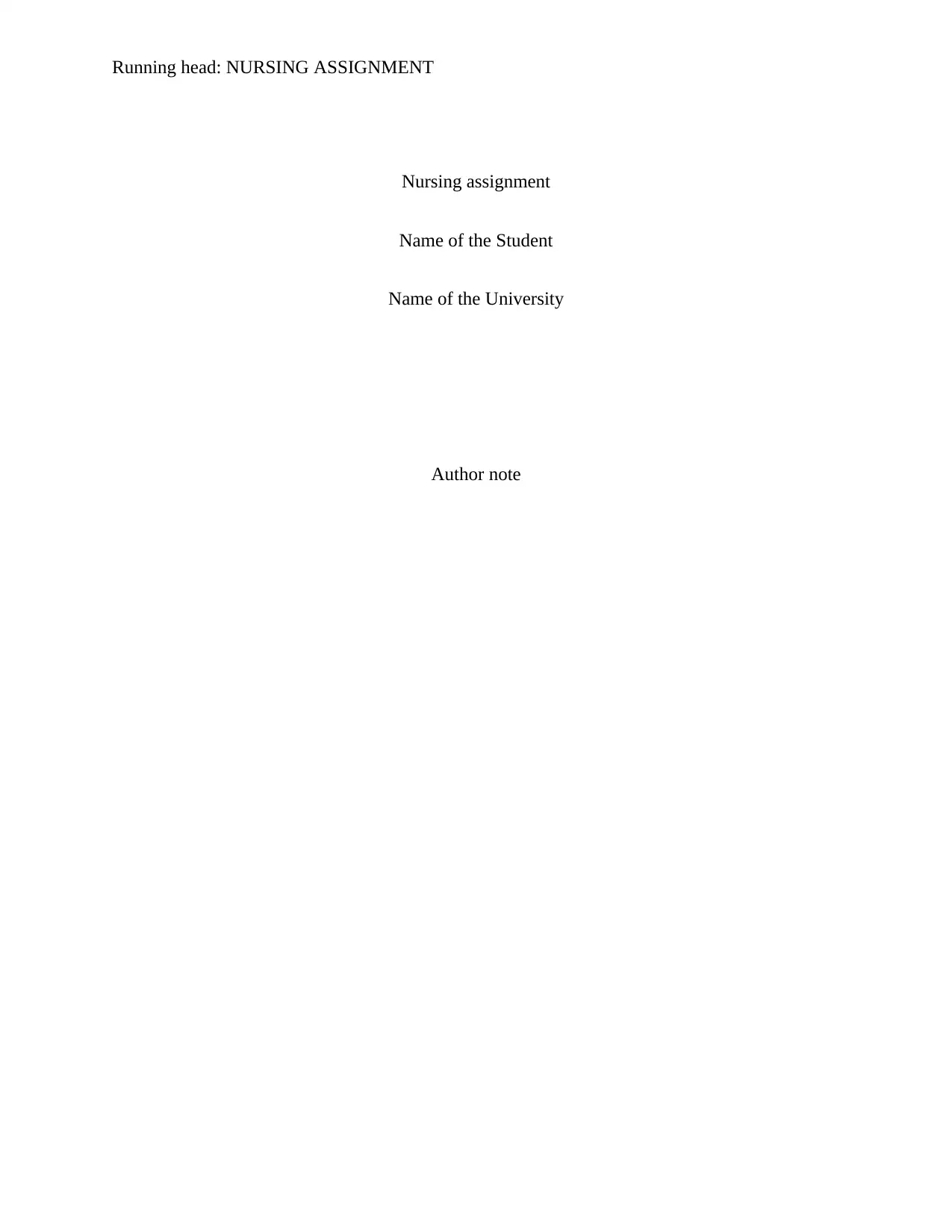
Running head: NURSING ASSIGNMENT
Nursing assignment
Name of the Student
Name of the University
Author note
Nursing assignment
Name of the Student
Name of the University
Author note
Paraphrase This Document
Need a fresh take? Get an instant paraphrase of this document with our AI Paraphraser
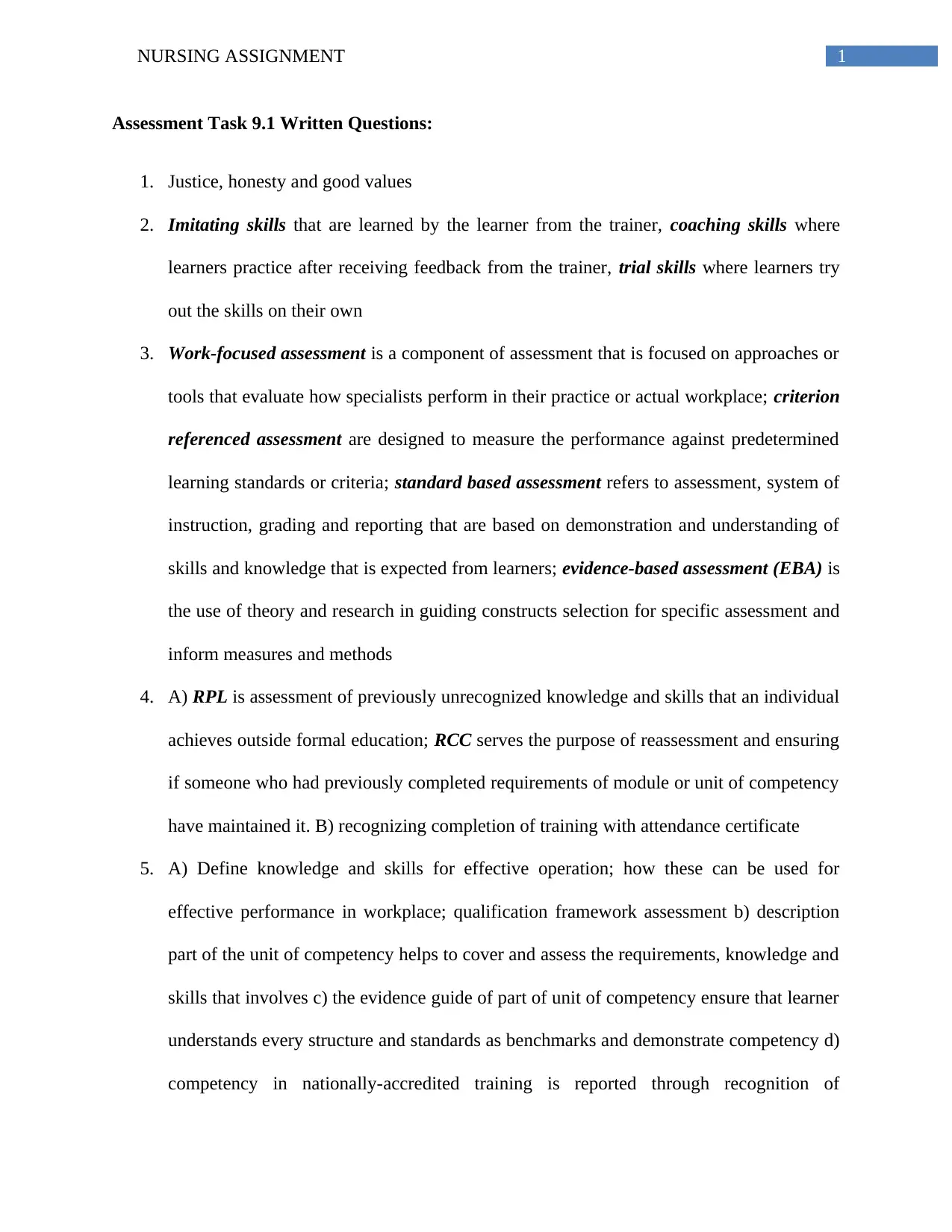
1NURSING ASSIGNMENT
Assessment Task 9.1 Written Questions:
1. Justice, honesty and good values
2. Imitating skills that are learned by the learner from the trainer, coaching skills where
learners practice after receiving feedback from the trainer, trial skills where learners try
out the skills on their own
3. Work-focused assessment is a component of assessment that is focused on approaches or
tools that evaluate how specialists perform in their practice or actual workplace; criterion
referenced assessment are designed to measure the performance against predetermined
learning standards or criteria; standard based assessment refers to assessment, system of
instruction, grading and reporting that are based on demonstration and understanding of
skills and knowledge that is expected from learners; evidence-based assessment (EBA) is
the use of theory and research in guiding constructs selection for specific assessment and
inform measures and methods
4. A) RPL is assessment of previously unrecognized knowledge and skills that an individual
achieves outside formal education; RCC serves the purpose of reassessment and ensuring
if someone who had previously completed requirements of module or unit of competency
have maintained it. B) recognizing completion of training with attendance certificate
5. A) Define knowledge and skills for effective operation; how these can be used for
effective performance in workplace; qualification framework assessment b) description
part of the unit of competency helps to cover and assess the requirements, knowledge and
skills that involves c) the evidence guide of part of unit of competency ensure that learner
understands every structure and standards as benchmarks and demonstrate competency d)
competency in nationally-accredited training is reported through recognition of
Assessment Task 9.1 Written Questions:
1. Justice, honesty and good values
2. Imitating skills that are learned by the learner from the trainer, coaching skills where
learners practice after receiving feedback from the trainer, trial skills where learners try
out the skills on their own
3. Work-focused assessment is a component of assessment that is focused on approaches or
tools that evaluate how specialists perform in their practice or actual workplace; criterion
referenced assessment are designed to measure the performance against predetermined
learning standards or criteria; standard based assessment refers to assessment, system of
instruction, grading and reporting that are based on demonstration and understanding of
skills and knowledge that is expected from learners; evidence-based assessment (EBA) is
the use of theory and research in guiding constructs selection for specific assessment and
inform measures and methods
4. A) RPL is assessment of previously unrecognized knowledge and skills that an individual
achieves outside formal education; RCC serves the purpose of reassessment and ensuring
if someone who had previously completed requirements of module or unit of competency
have maintained it. B) recognizing completion of training with attendance certificate
5. A) Define knowledge and skills for effective operation; how these can be used for
effective performance in workplace; qualification framework assessment b) description
part of the unit of competency helps to cover and assess the requirements, knowledge and
skills that involves c) the evidence guide of part of unit of competency ensure that learner
understands every structure and standards as benchmarks and demonstrate competency d)
competency in nationally-accredited training is reported through recognition of
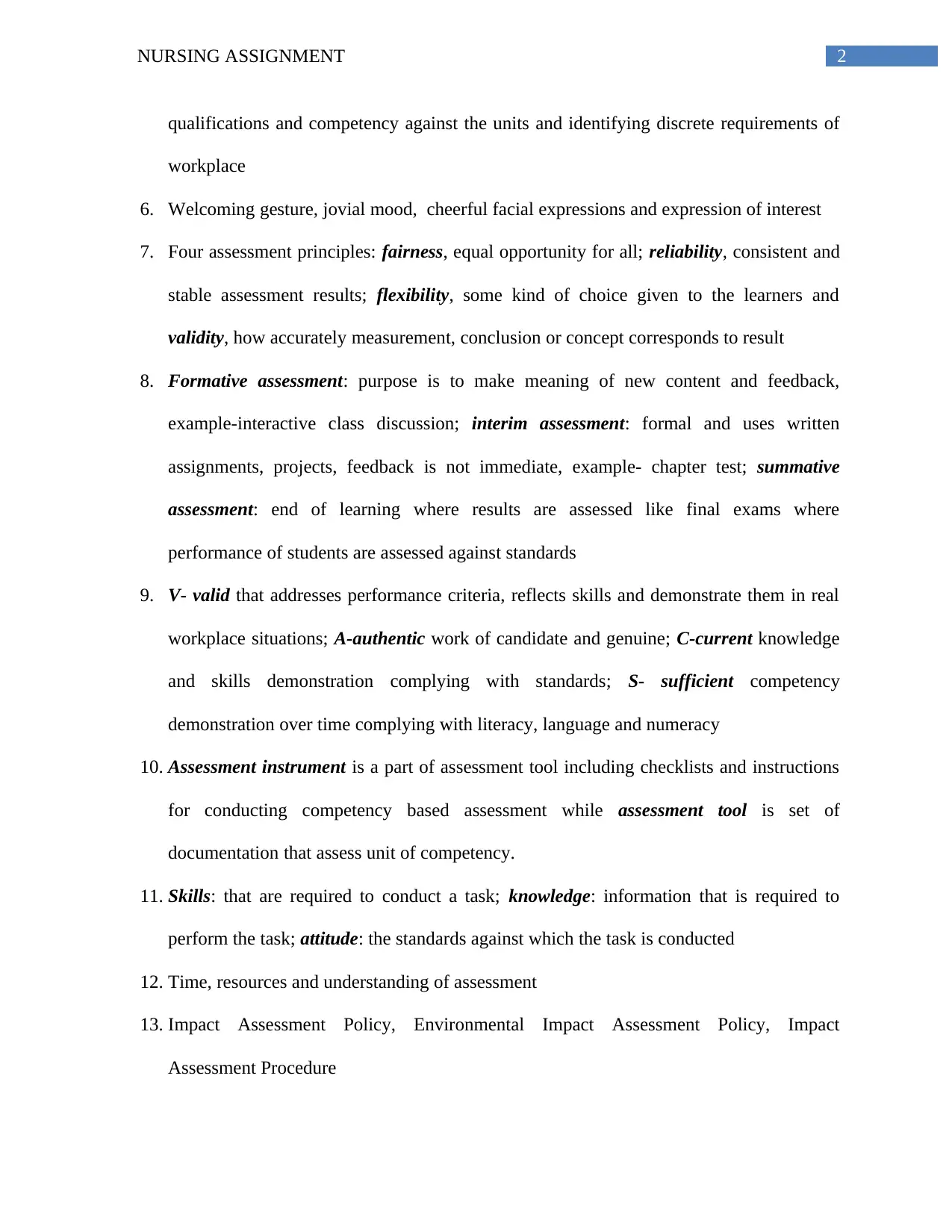
2NURSING ASSIGNMENT
qualifications and competency against the units and identifying discrete requirements of
workplace
6. Welcoming gesture, jovial mood, cheerful facial expressions and expression of interest
7. Four assessment principles: fairness, equal opportunity for all; reliability, consistent and
stable assessment results; flexibility, some kind of choice given to the learners and
validity, how accurately measurement, conclusion or concept corresponds to result
8. Formative assessment: purpose is to make meaning of new content and feedback,
example-interactive class discussion; interim assessment: formal and uses written
assignments, projects, feedback is not immediate, example- chapter test; summative
assessment: end of learning where results are assessed like final exams where
performance of students are assessed against standards
9. V- valid that addresses performance criteria, reflects skills and demonstrate them in real
workplace situations; A-authentic work of candidate and genuine; C-current knowledge
and skills demonstration complying with standards; S- sufficient competency
demonstration over time complying with literacy, language and numeracy
10. Assessment instrument is a part of assessment tool including checklists and instructions
for conducting competency based assessment while assessment tool is set of
documentation that assess unit of competency.
11. Skills: that are required to conduct a task; knowledge: information that is required to
perform the task; attitude: the standards against which the task is conducted
12. Time, resources and understanding of assessment
13. Impact Assessment Policy, Environmental Impact Assessment Policy, Impact
Assessment Procedure
qualifications and competency against the units and identifying discrete requirements of
workplace
6. Welcoming gesture, jovial mood, cheerful facial expressions and expression of interest
7. Four assessment principles: fairness, equal opportunity for all; reliability, consistent and
stable assessment results; flexibility, some kind of choice given to the learners and
validity, how accurately measurement, conclusion or concept corresponds to result
8. Formative assessment: purpose is to make meaning of new content and feedback,
example-interactive class discussion; interim assessment: formal and uses written
assignments, projects, feedback is not immediate, example- chapter test; summative
assessment: end of learning where results are assessed like final exams where
performance of students are assessed against standards
9. V- valid that addresses performance criteria, reflects skills and demonstrate them in real
workplace situations; A-authentic work of candidate and genuine; C-current knowledge
and skills demonstration complying with standards; S- sufficient competency
demonstration over time complying with literacy, language and numeracy
10. Assessment instrument is a part of assessment tool including checklists and instructions
for conducting competency based assessment while assessment tool is set of
documentation that assess unit of competency.
11. Skills: that are required to conduct a task; knowledge: information that is required to
perform the task; attitude: the standards against which the task is conducted
12. Time, resources and understanding of assessment
13. Impact Assessment Policy, Environmental Impact Assessment Policy, Impact
Assessment Procedure
⊘ This is a preview!⊘
Do you want full access?
Subscribe today to unlock all pages.

Trusted by 1+ million students worldwide
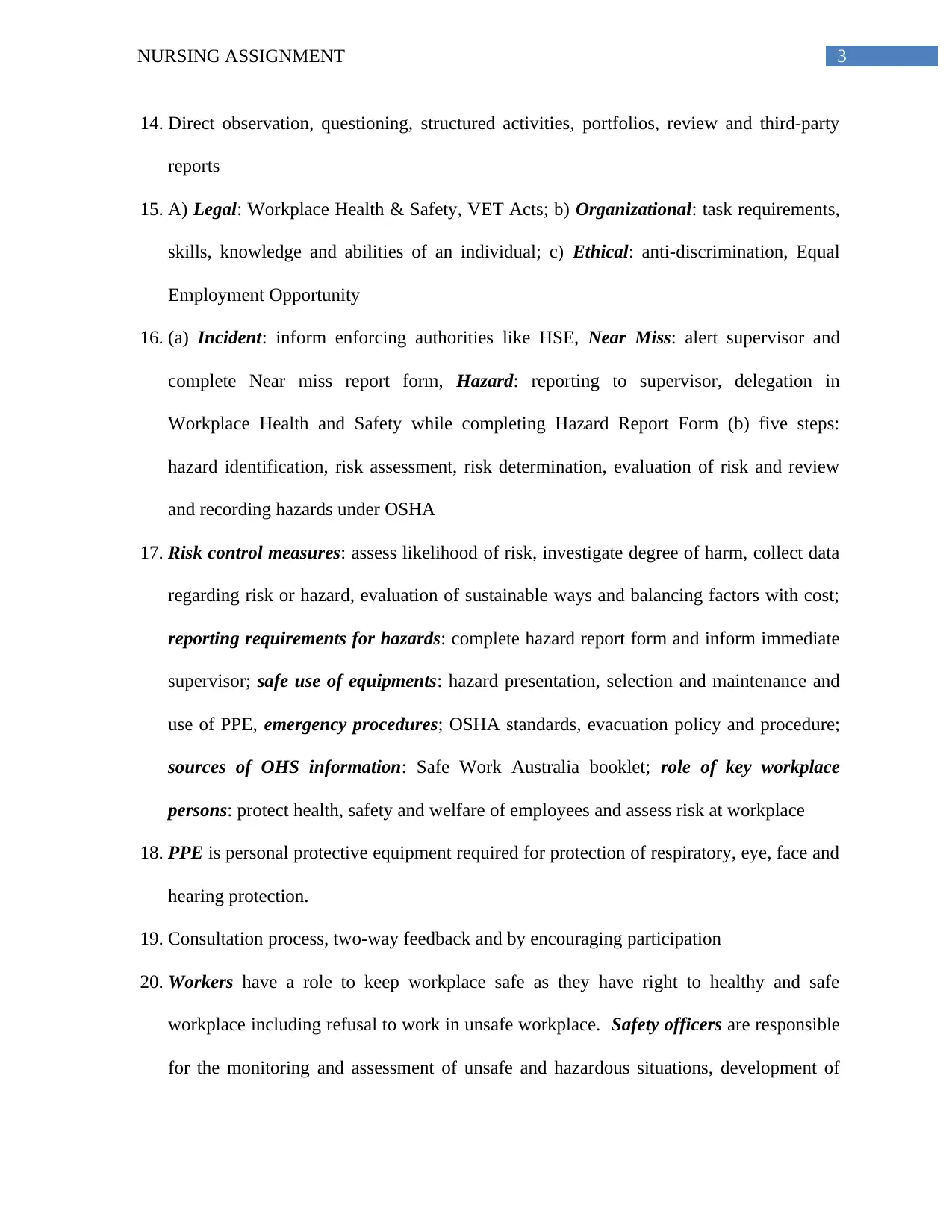
3NURSING ASSIGNMENT
14. Direct observation, questioning, structured activities, portfolios, review and third-party
reports
15. A) Legal: Workplace Health & Safety, VET Acts; b) Organizational: task requirements,
skills, knowledge and abilities of an individual; c) Ethical: anti-discrimination, Equal
Employment Opportunity
16. (a) Incident: inform enforcing authorities like HSE, Near Miss: alert supervisor and
complete Near miss report form, Hazard: reporting to supervisor, delegation in
Workplace Health and Safety while completing Hazard Report Form (b) five steps:
hazard identification, risk assessment, risk determination, evaluation of risk and review
and recording hazards under OSHA
17. Risk control measures: assess likelihood of risk, investigate degree of harm, collect data
regarding risk or hazard, evaluation of sustainable ways and balancing factors with cost;
reporting requirements for hazards: complete hazard report form and inform immediate
supervisor; safe use of equipments: hazard presentation, selection and maintenance and
use of PPE, emergency procedures; OSHA standards, evacuation policy and procedure;
sources of OHS information: Safe Work Australia booklet; role of key workplace
persons: protect health, safety and welfare of employees and assess risk at workplace
18. PPE is personal protective equipment required for protection of respiratory, eye, face and
hearing protection.
19. Consultation process, two-way feedback and by encouraging participation
20. Workers have a role to keep workplace safe as they have right to healthy and safe
workplace including refusal to work in unsafe workplace. Safety officers are responsible
for the monitoring and assessment of unsafe and hazardous situations, development of
14. Direct observation, questioning, structured activities, portfolios, review and third-party
reports
15. A) Legal: Workplace Health & Safety, VET Acts; b) Organizational: task requirements,
skills, knowledge and abilities of an individual; c) Ethical: anti-discrimination, Equal
Employment Opportunity
16. (a) Incident: inform enforcing authorities like HSE, Near Miss: alert supervisor and
complete Near miss report form, Hazard: reporting to supervisor, delegation in
Workplace Health and Safety while completing Hazard Report Form (b) five steps:
hazard identification, risk assessment, risk determination, evaluation of risk and review
and recording hazards under OSHA
17. Risk control measures: assess likelihood of risk, investigate degree of harm, collect data
regarding risk or hazard, evaluation of sustainable ways and balancing factors with cost;
reporting requirements for hazards: complete hazard report form and inform immediate
supervisor; safe use of equipments: hazard presentation, selection and maintenance and
use of PPE, emergency procedures; OSHA standards, evacuation policy and procedure;
sources of OHS information: Safe Work Australia booklet; role of key workplace
persons: protect health, safety and welfare of employees and assess risk at workplace
18. PPE is personal protective equipment required for protection of respiratory, eye, face and
hearing protection.
19. Consultation process, two-way feedback and by encouraging participation
20. Workers have a role to keep workplace safe as they have right to healthy and safe
workplace including refusal to work in unsafe workplace. Safety officers are responsible
for the monitoring and assessment of unsafe and hazardous situations, development of
Paraphrase This Document
Need a fresh take? Get an instant paraphrase of this document with our AI Paraphraser
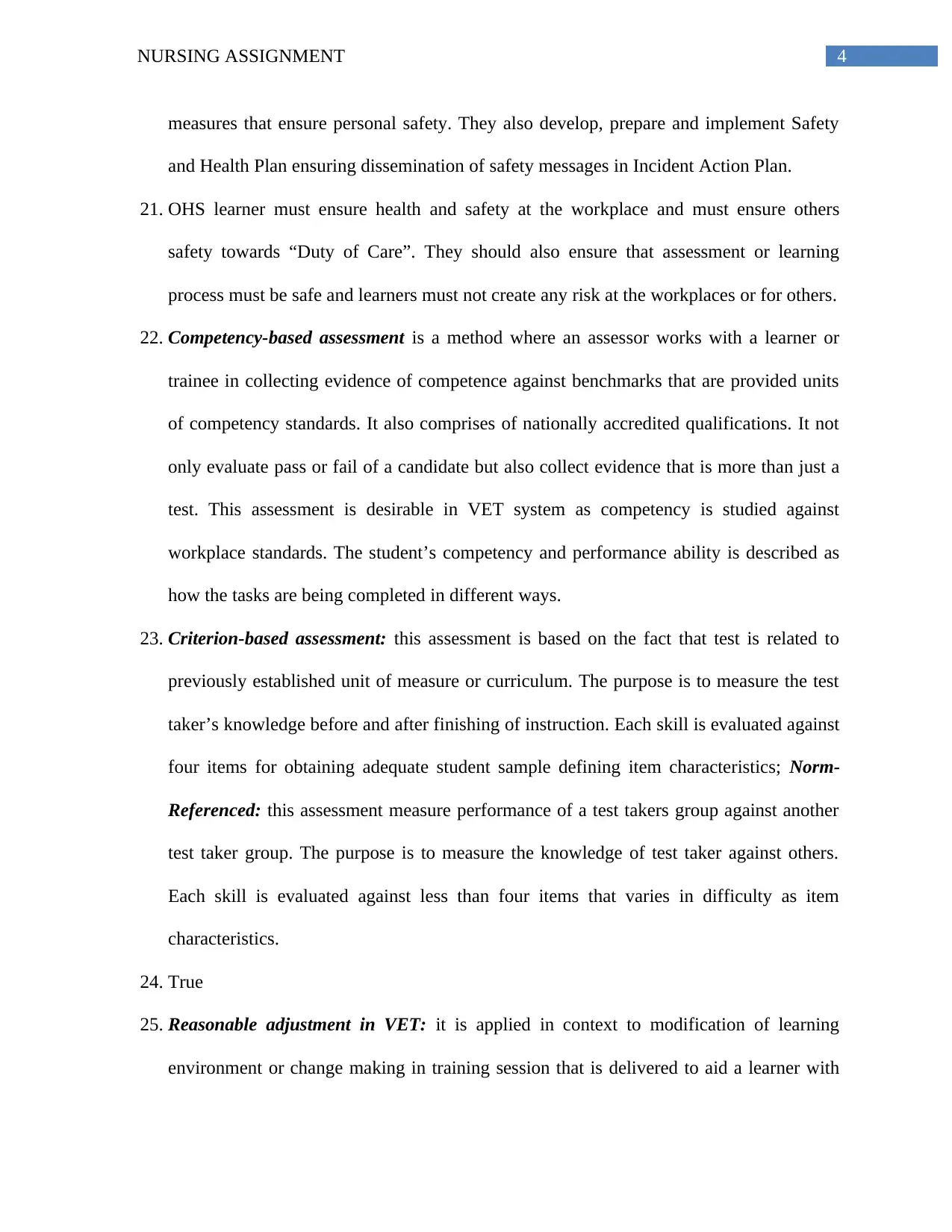
4NURSING ASSIGNMENT
measures that ensure personal safety. They also develop, prepare and implement Safety
and Health Plan ensuring dissemination of safety messages in Incident Action Plan.
21. OHS learner must ensure health and safety at the workplace and must ensure others
safety towards “Duty of Care”. They should also ensure that assessment or learning
process must be safe and learners must not create any risk at the workplaces or for others.
22. Competency-based assessment is a method where an assessor works with a learner or
trainee in collecting evidence of competence against benchmarks that are provided units
of competency standards. It also comprises of nationally accredited qualifications. It not
only evaluate pass or fail of a candidate but also collect evidence that is more than just a
test. This assessment is desirable in VET system as competency is studied against
workplace standards. The student’s competency and performance ability is described as
how the tasks are being completed in different ways.
23. Criterion-based assessment: this assessment is based on the fact that test is related to
previously established unit of measure or curriculum. The purpose is to measure the test
taker’s knowledge before and after finishing of instruction. Each skill is evaluated against
four items for obtaining adequate student sample defining item characteristics; Norm-
Referenced: this assessment measure performance of a test takers group against another
test taker group. The purpose is to measure the knowledge of test taker against others.
Each skill is evaluated against less than four items that varies in difficulty as item
characteristics.
24. True
25. Reasonable adjustment in VET: it is applied in context to modification of learning
environment or change making in training session that is delivered to aid a learner with
measures that ensure personal safety. They also develop, prepare and implement Safety
and Health Plan ensuring dissemination of safety messages in Incident Action Plan.
21. OHS learner must ensure health and safety at the workplace and must ensure others
safety towards “Duty of Care”. They should also ensure that assessment or learning
process must be safe and learners must not create any risk at the workplaces or for others.
22. Competency-based assessment is a method where an assessor works with a learner or
trainee in collecting evidence of competence against benchmarks that are provided units
of competency standards. It also comprises of nationally accredited qualifications. It not
only evaluate pass or fail of a candidate but also collect evidence that is more than just a
test. This assessment is desirable in VET system as competency is studied against
workplace standards. The student’s competency and performance ability is described as
how the tasks are being completed in different ways.
23. Criterion-based assessment: this assessment is based on the fact that test is related to
previously established unit of measure or curriculum. The purpose is to measure the test
taker’s knowledge before and after finishing of instruction. Each skill is evaluated against
four items for obtaining adequate student sample defining item characteristics; Norm-
Referenced: this assessment measure performance of a test takers group against another
test taker group. The purpose is to measure the knowledge of test taker against others.
Each skill is evaluated against less than four items that varies in difficulty as item
characteristics.
24. True
25. Reasonable adjustment in VET: it is applied in context to modification of learning
environment or change making in training session that is delivered to aid a learner with
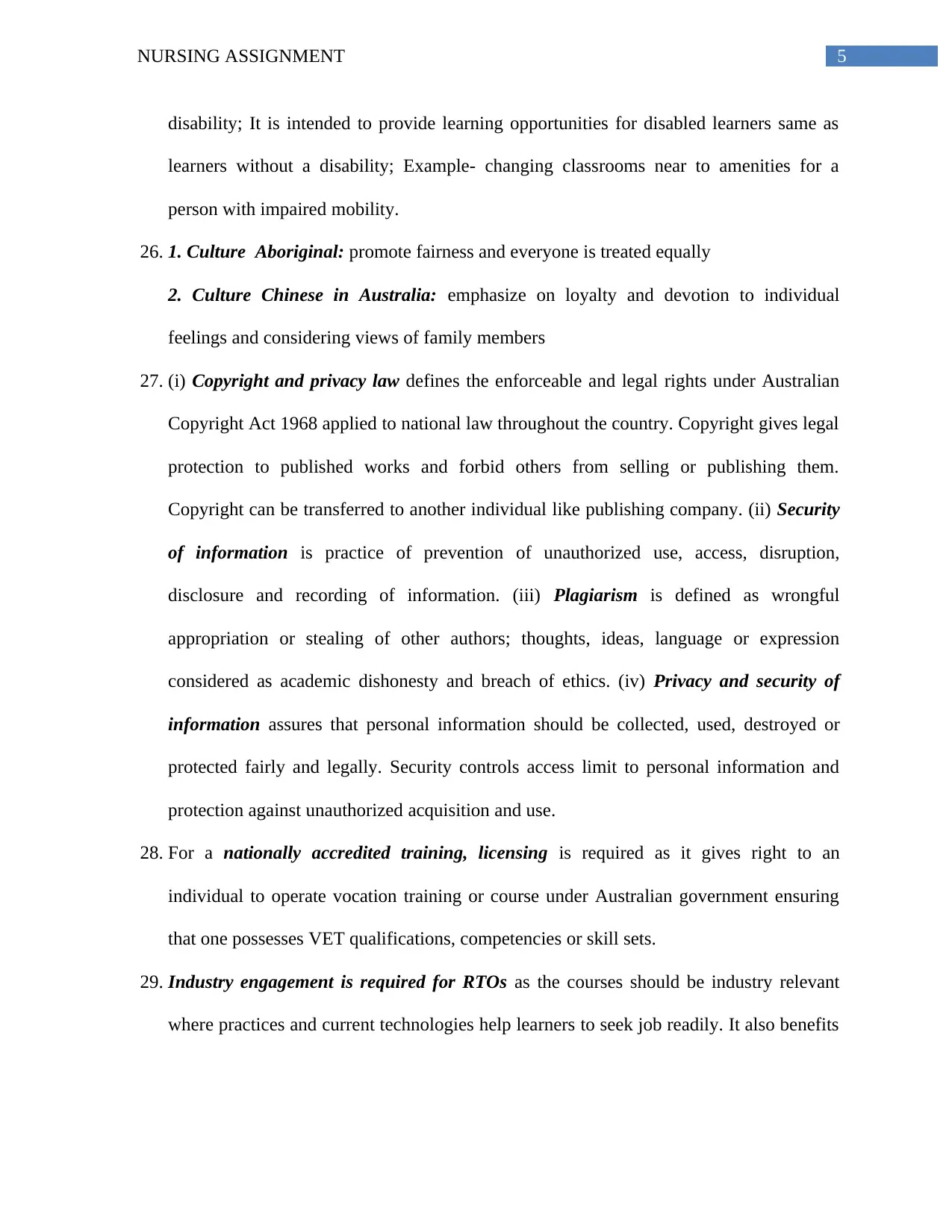
5NURSING ASSIGNMENT
disability; It is intended to provide learning opportunities for disabled learners same as
learners without a disability; Example- changing classrooms near to amenities for a
person with impaired mobility.
26. 1. Culture Aboriginal: promote fairness and everyone is treated equally
2. Culture Chinese in Australia: emphasize on loyalty and devotion to individual
feelings and considering views of family members
27. (i) Copyright and privacy law defines the enforceable and legal rights under Australian
Copyright Act 1968 applied to national law throughout the country. Copyright gives legal
protection to published works and forbid others from selling or publishing them.
Copyright can be transferred to another individual like publishing company. (ii) Security
of information is practice of prevention of unauthorized use, access, disruption,
disclosure and recording of information. (iii) Plagiarism is defined as wrongful
appropriation or stealing of other authors; thoughts, ideas, language or expression
considered as academic dishonesty and breach of ethics. (iv) Privacy and security of
information assures that personal information should be collected, used, destroyed or
protected fairly and legally. Security controls access limit to personal information and
protection against unauthorized acquisition and use.
28. For a nationally accredited training, licensing is required as it gives right to an
individual to operate vocation training or course under Australian government ensuring
that one possesses VET qualifications, competencies or skill sets.
29. Industry engagement is required for RTOs as the courses should be industry relevant
where practices and current technologies help learners to seek job readily. It also benefits
disability; It is intended to provide learning opportunities for disabled learners same as
learners without a disability; Example- changing classrooms near to amenities for a
person with impaired mobility.
26. 1. Culture Aboriginal: promote fairness and everyone is treated equally
2. Culture Chinese in Australia: emphasize on loyalty and devotion to individual
feelings and considering views of family members
27. (i) Copyright and privacy law defines the enforceable and legal rights under Australian
Copyright Act 1968 applied to national law throughout the country. Copyright gives legal
protection to published works and forbid others from selling or publishing them.
Copyright can be transferred to another individual like publishing company. (ii) Security
of information is practice of prevention of unauthorized use, access, disruption,
disclosure and recording of information. (iii) Plagiarism is defined as wrongful
appropriation or stealing of other authors; thoughts, ideas, language or expression
considered as academic dishonesty and breach of ethics. (iv) Privacy and security of
information assures that personal information should be collected, used, destroyed or
protected fairly and legally. Security controls access limit to personal information and
protection against unauthorized acquisition and use.
28. For a nationally accredited training, licensing is required as it gives right to an
individual to operate vocation training or course under Australian government ensuring
that one possesses VET qualifications, competencies or skill sets.
29. Industry engagement is required for RTOs as the courses should be industry relevant
where practices and current technologies help learners to seek job readily. It also benefits
⊘ This is a preview!⊘
Do you want full access?
Subscribe today to unlock all pages.

Trusted by 1+ million students worldwide
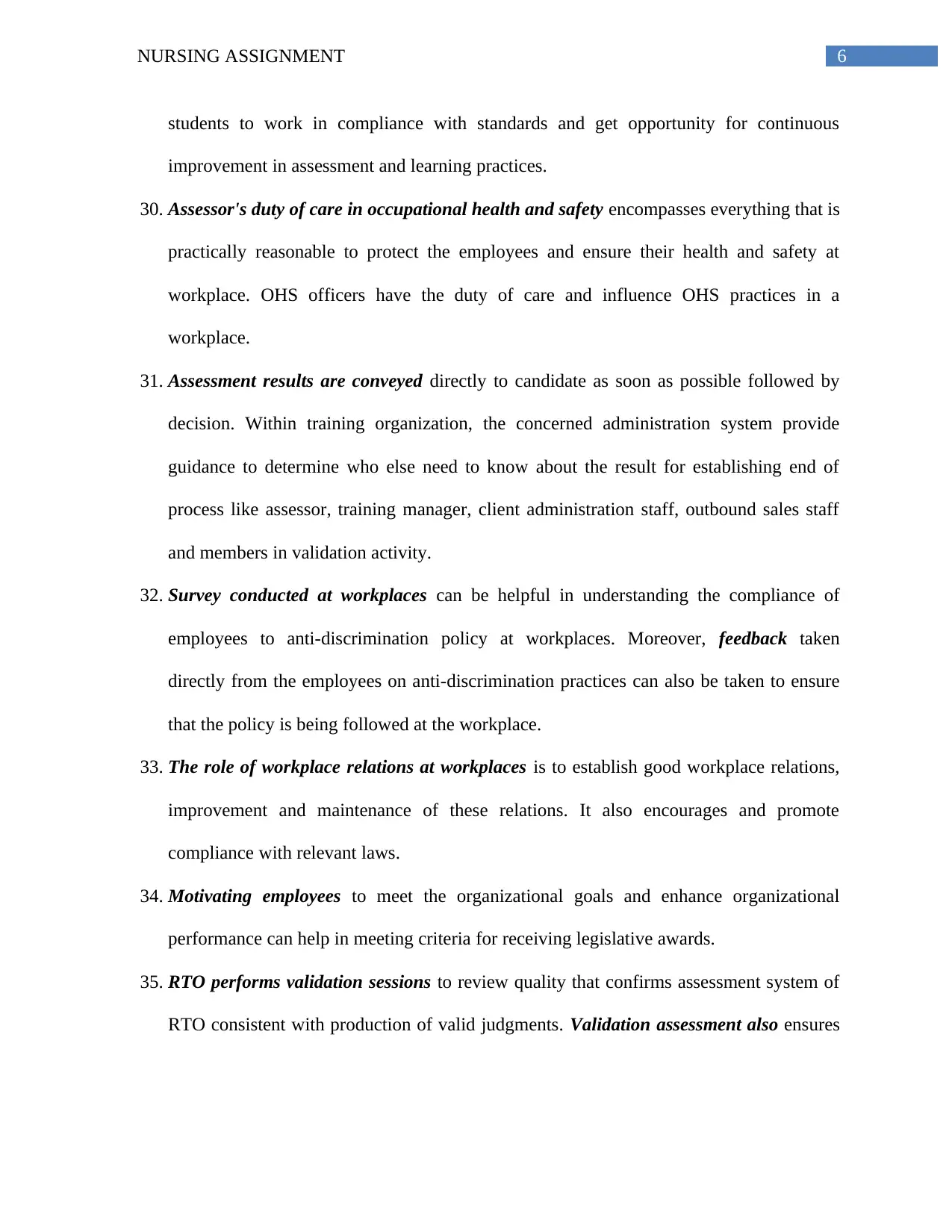
6NURSING ASSIGNMENT
students to work in compliance with standards and get opportunity for continuous
improvement in assessment and learning practices.
30. Assessor's duty of care in occupational health and safety encompasses everything that is
practically reasonable to protect the employees and ensure their health and safety at
workplace. OHS officers have the duty of care and influence OHS practices in a
workplace.
31. Assessment results are conveyed directly to candidate as soon as possible followed by
decision. Within training organization, the concerned administration system provide
guidance to determine who else need to know about the result for establishing end of
process like assessor, training manager, client administration staff, outbound sales staff
and members in validation activity.
32. Survey conducted at workplaces can be helpful in understanding the compliance of
employees to anti-discrimination policy at workplaces. Moreover, feedback taken
directly from the employees on anti-discrimination practices can also be taken to ensure
that the policy is being followed at the workplace.
33. The role of workplace relations at workplaces is to establish good workplace relations,
improvement and maintenance of these relations. It also encourages and promote
compliance with relevant laws.
34. Motivating employees to meet the organizational goals and enhance organizational
performance can help in meeting criteria for receiving legislative awards.
35. RTO performs validation sessions to review quality that confirms assessment system of
RTO consistent with production of valid judgments. Validation assessment also ensures
students to work in compliance with standards and get opportunity for continuous
improvement in assessment and learning practices.
30. Assessor's duty of care in occupational health and safety encompasses everything that is
practically reasonable to protect the employees and ensure their health and safety at
workplace. OHS officers have the duty of care and influence OHS practices in a
workplace.
31. Assessment results are conveyed directly to candidate as soon as possible followed by
decision. Within training organization, the concerned administration system provide
guidance to determine who else need to know about the result for establishing end of
process like assessor, training manager, client administration staff, outbound sales staff
and members in validation activity.
32. Survey conducted at workplaces can be helpful in understanding the compliance of
employees to anti-discrimination policy at workplaces. Moreover, feedback taken
directly from the employees on anti-discrimination practices can also be taken to ensure
that the policy is being followed at the workplace.
33. The role of workplace relations at workplaces is to establish good workplace relations,
improvement and maintenance of these relations. It also encourages and promote
compliance with relevant laws.
34. Motivating employees to meet the organizational goals and enhance organizational
performance can help in meeting criteria for receiving legislative awards.
35. RTO performs validation sessions to review quality that confirms assessment system of
RTO consistent with production of valid judgments. Validation assessment also ensures
Paraphrase This Document
Need a fresh take? Get an instant paraphrase of this document with our AI Paraphraser
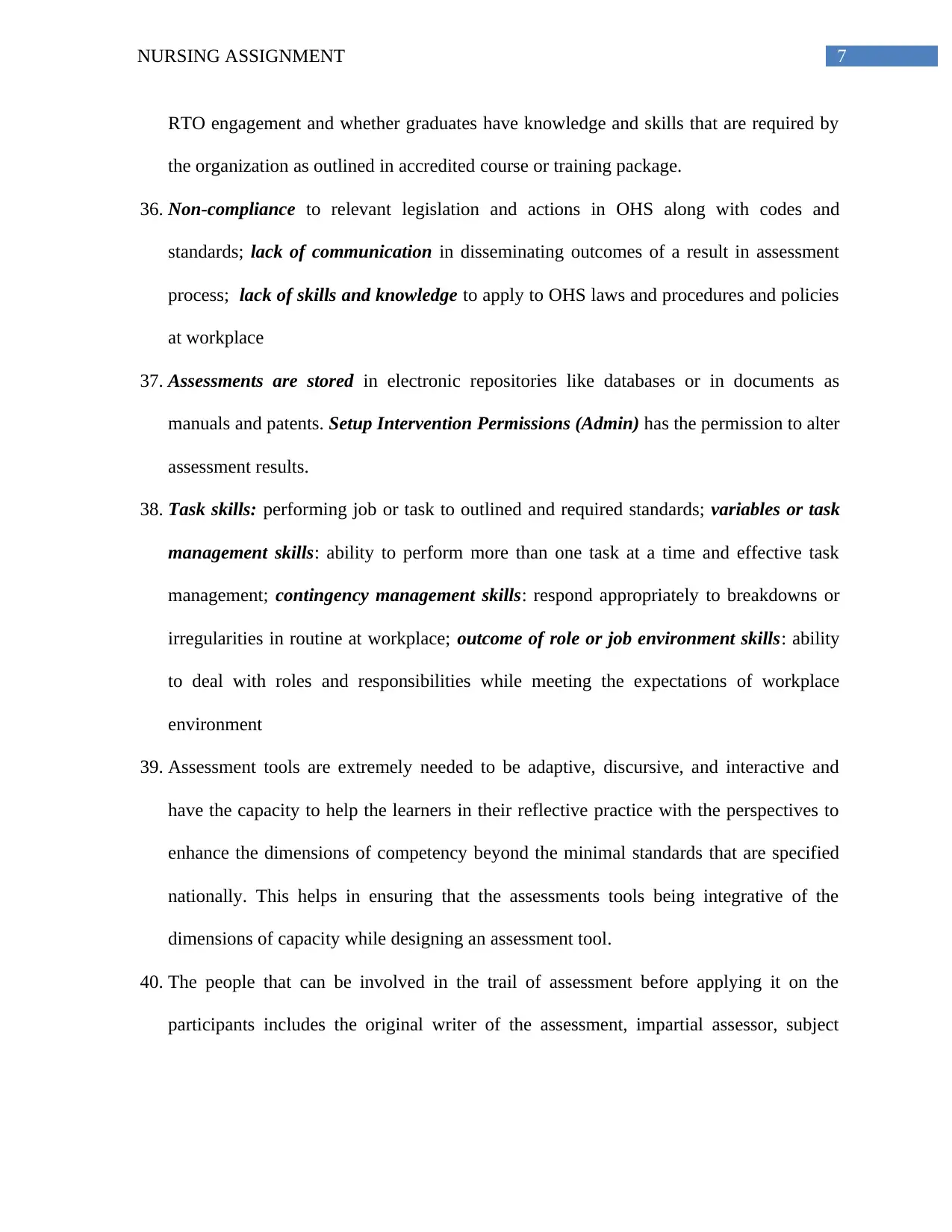
7NURSING ASSIGNMENT
RTO engagement and whether graduates have knowledge and skills that are required by
the organization as outlined in accredited course or training package.
36. Non-compliance to relevant legislation and actions in OHS along with codes and
standards; lack of communication in disseminating outcomes of a result in assessment
process; lack of skills and knowledge to apply to OHS laws and procedures and policies
at workplace
37. Assessments are stored in electronic repositories like databases or in documents as
manuals and patents. Setup Intervention Permissions (Admin) has the permission to alter
assessment results.
38. Task skills: performing job or task to outlined and required standards; variables or task
management skills: ability to perform more than one task at a time and effective task
management; contingency management skills: respond appropriately to breakdowns or
irregularities in routine at workplace; outcome of role or job environment skills: ability
to deal with roles and responsibilities while meeting the expectations of workplace
environment
39. Assessment tools are extremely needed to be adaptive, discursive, and interactive and
have the capacity to help the learners in their reflective practice with the perspectives to
enhance the dimensions of competency beyond the minimal standards that are specified
nationally. This helps in ensuring that the assessments tools being integrative of the
dimensions of capacity while designing an assessment tool.
40. The people that can be involved in the trail of assessment before applying it on the
participants includes the original writer of the assessment, impartial assessor, subject
RTO engagement and whether graduates have knowledge and skills that are required by
the organization as outlined in accredited course or training package.
36. Non-compliance to relevant legislation and actions in OHS along with codes and
standards; lack of communication in disseminating outcomes of a result in assessment
process; lack of skills and knowledge to apply to OHS laws and procedures and policies
at workplace
37. Assessments are stored in electronic repositories like databases or in documents as
manuals and patents. Setup Intervention Permissions (Admin) has the permission to alter
assessment results.
38. Task skills: performing job or task to outlined and required standards; variables or task
management skills: ability to perform more than one task at a time and effective task
management; contingency management skills: respond appropriately to breakdowns or
irregularities in routine at workplace; outcome of role or job environment skills: ability
to deal with roles and responsibilities while meeting the expectations of workplace
environment
39. Assessment tools are extremely needed to be adaptive, discursive, and interactive and
have the capacity to help the learners in their reflective practice with the perspectives to
enhance the dimensions of competency beyond the minimal standards that are specified
nationally. This helps in ensuring that the assessments tools being integrative of the
dimensions of capacity while designing an assessment tool.
40. The people that can be involved in the trail of assessment before applying it on the
participants includes the original writer of the assessment, impartial assessor, subject
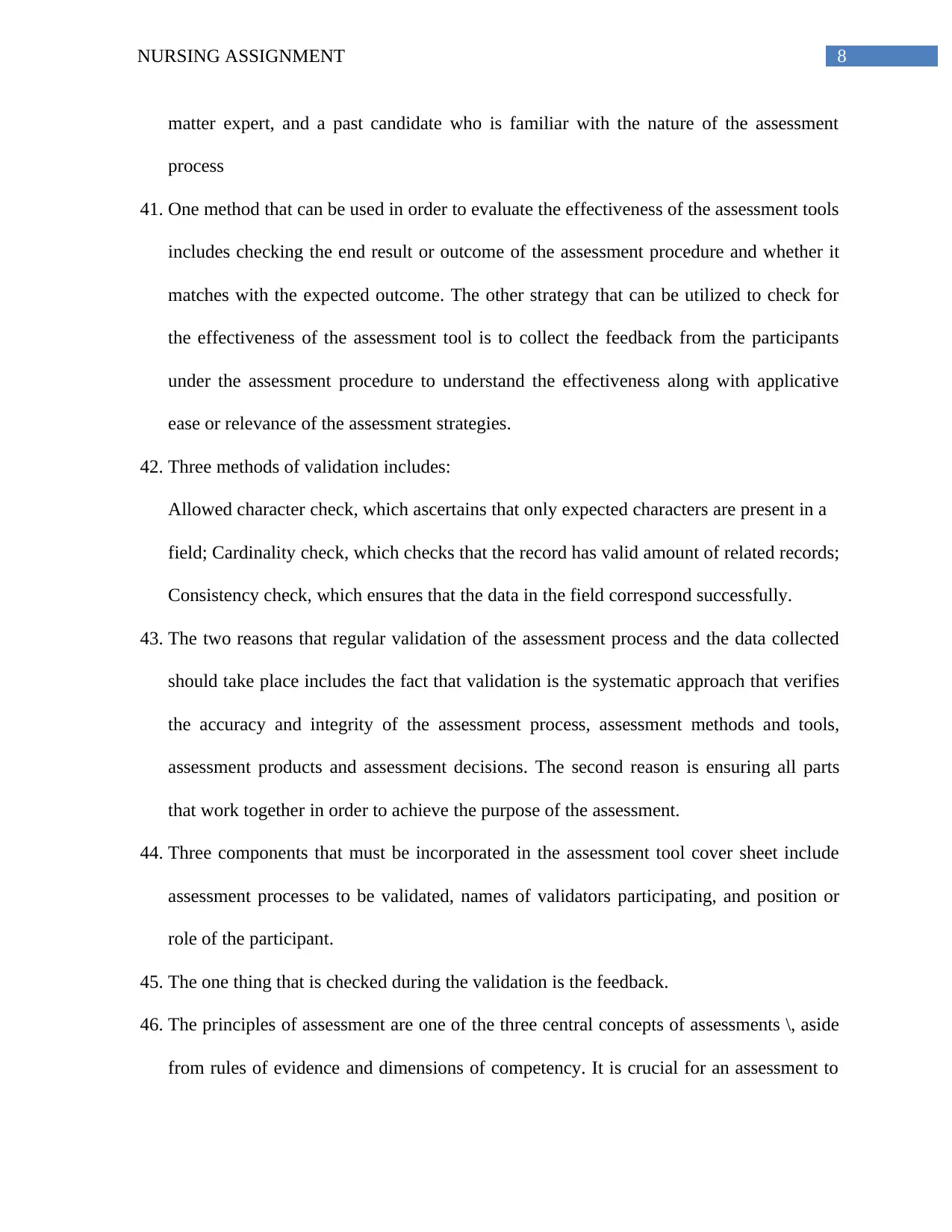
8NURSING ASSIGNMENT
matter expert, and a past candidate who is familiar with the nature of the assessment
process
41. One method that can be used in order to evaluate the effectiveness of the assessment tools
includes checking the end result or outcome of the assessment procedure and whether it
matches with the expected outcome. The other strategy that can be utilized to check for
the effectiveness of the assessment tool is to collect the feedback from the participants
under the assessment procedure to understand the effectiveness along with applicative
ease or relevance of the assessment strategies.
42. Three methods of validation includes:
Allowed character check, which ascertains that only expected characters are present in a
field; Cardinality check, which checks that the record has valid amount of related records;
Consistency check, which ensures that the data in the field correspond successfully.
43. The two reasons that regular validation of the assessment process and the data collected
should take place includes the fact that validation is the systematic approach that verifies
the accuracy and integrity of the assessment process, assessment methods and tools,
assessment products and assessment decisions. The second reason is ensuring all parts
that work together in order to achieve the purpose of the assessment.
44. Three components that must be incorporated in the assessment tool cover sheet include
assessment processes to be validated, names of validators participating, and position or
role of the participant.
45. The one thing that is checked during the validation is the feedback.
46. The principles of assessment are one of the three central concepts of assessments \, aside
from rules of evidence and dimensions of competency. It is crucial for an assessment to
matter expert, and a past candidate who is familiar with the nature of the assessment
process
41. One method that can be used in order to evaluate the effectiveness of the assessment tools
includes checking the end result or outcome of the assessment procedure and whether it
matches with the expected outcome. The other strategy that can be utilized to check for
the effectiveness of the assessment tool is to collect the feedback from the participants
under the assessment procedure to understand the effectiveness along with applicative
ease or relevance of the assessment strategies.
42. Three methods of validation includes:
Allowed character check, which ascertains that only expected characters are present in a
field; Cardinality check, which checks that the record has valid amount of related records;
Consistency check, which ensures that the data in the field correspond successfully.
43. The two reasons that regular validation of the assessment process and the data collected
should take place includes the fact that validation is the systematic approach that verifies
the accuracy and integrity of the assessment process, assessment methods and tools,
assessment products and assessment decisions. The second reason is ensuring all parts
that work together in order to achieve the purpose of the assessment.
44. Three components that must be incorporated in the assessment tool cover sheet include
assessment processes to be validated, names of validators participating, and position or
role of the participant.
45. The one thing that is checked during the validation is the feedback.
46. The principles of assessment are one of the three central concepts of assessments \, aside
from rules of evidence and dimensions of competency. It is crucial for an assessment to
⊘ This is a preview!⊘
Do you want full access?
Subscribe today to unlock all pages.

Trusted by 1+ million students worldwide
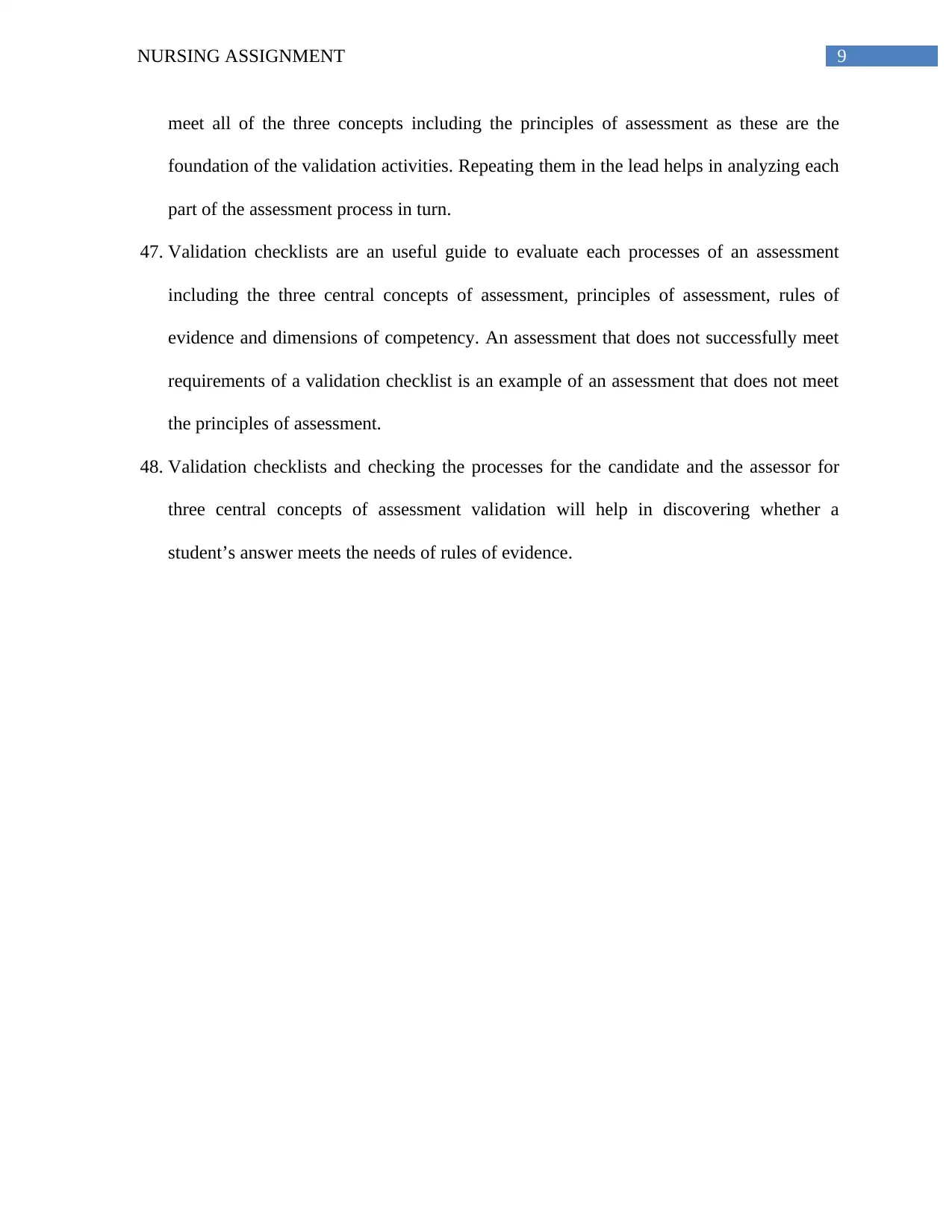
9NURSING ASSIGNMENT
meet all of the three concepts including the principles of assessment as these are the
foundation of the validation activities. Repeating them in the lead helps in analyzing each
part of the assessment process in turn.
47. Validation checklists are an useful guide to evaluate each processes of an assessment
including the three central concepts of assessment, principles of assessment, rules of
evidence and dimensions of competency. An assessment that does not successfully meet
requirements of a validation checklist is an example of an assessment that does not meet
the principles of assessment.
48. Validation checklists and checking the processes for the candidate and the assessor for
three central concepts of assessment validation will help in discovering whether a
student’s answer meets the needs of rules of evidence.
meet all of the three concepts including the principles of assessment as these are the
foundation of the validation activities. Repeating them in the lead helps in analyzing each
part of the assessment process in turn.
47. Validation checklists are an useful guide to evaluate each processes of an assessment
including the three central concepts of assessment, principles of assessment, rules of
evidence and dimensions of competency. An assessment that does not successfully meet
requirements of a validation checklist is an example of an assessment that does not meet
the principles of assessment.
48. Validation checklists and checking the processes for the candidate and the assessor for
three central concepts of assessment validation will help in discovering whether a
student’s answer meets the needs of rules of evidence.
1 out of 10
Related Documents
Your All-in-One AI-Powered Toolkit for Academic Success.
+13062052269
info@desklib.com
Available 24*7 on WhatsApp / Email
![[object Object]](/_next/static/media/star-bottom.7253800d.svg)
Unlock your academic potential
Copyright © 2020–2025 A2Z Services. All Rights Reserved. Developed and managed by ZUCOL.





